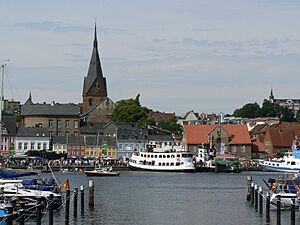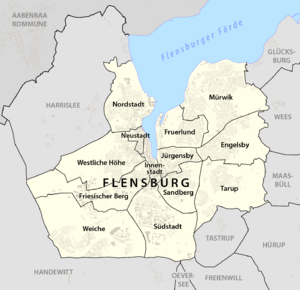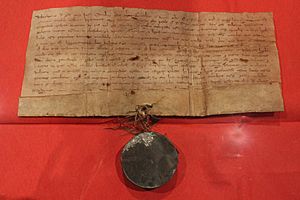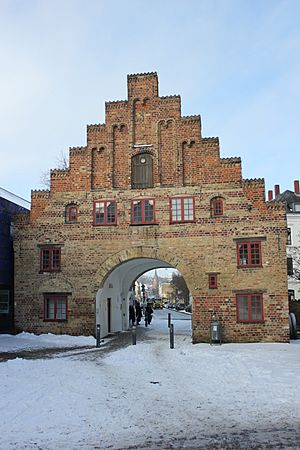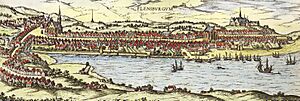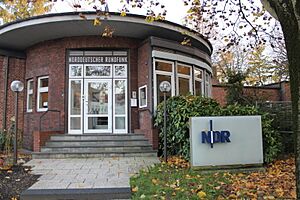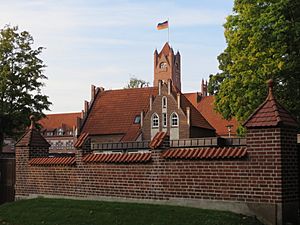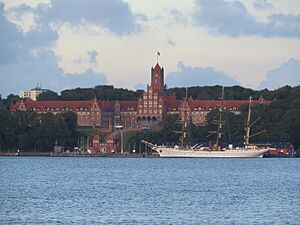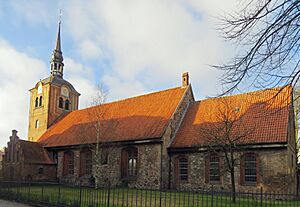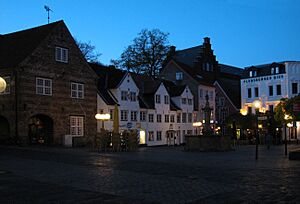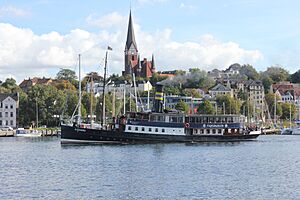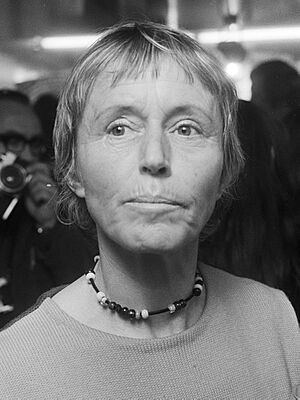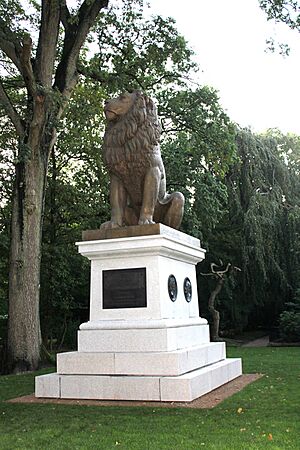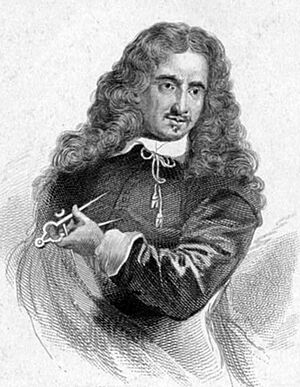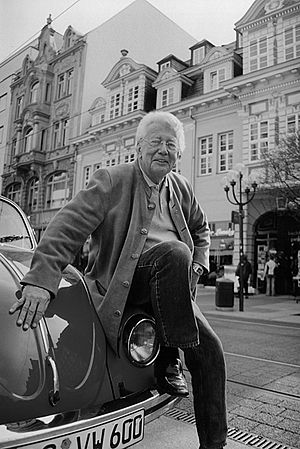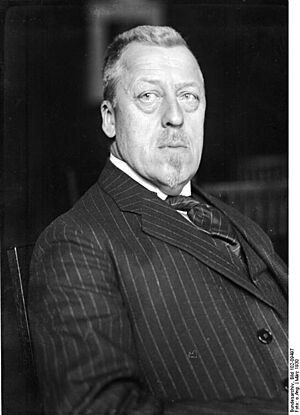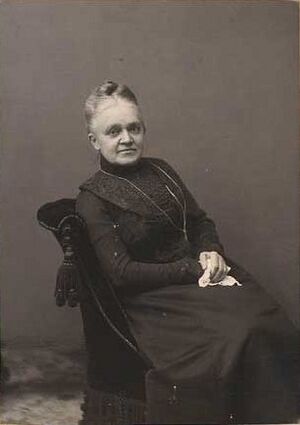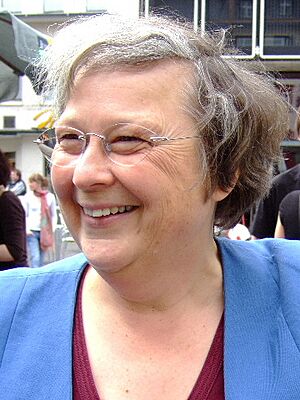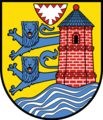Flensburg facts for kids
Quick facts for kids
Flensburg
|
|||
|---|---|---|---|

Flensburg Harbour in 2012
|
|||
|
|||
| Country | Germany | ||
| State | Schleswig-Holstein | ||
| District | Urban district | ||
| Elevation | 12 m (39 ft) | ||
| Population
(2022-12-31)
|
|||
| • Total | 92,550 | ||
| Time zone | CET/CEST (UTC+1/+2) | ||
| Postal codes |
24901–24944
|
||
| Dialling codes | 0461 | ||
| Vehicle registration | FL | ||
| Website | www.flensburg.de | ||
Flensburg is an important town in the very north of Germany. It is located in the state of Schleswig-Holstein. After Kiel and Lübeck, Flensburg is the third-largest town in this state.
The town center of Flensburg is only about 7 kilometers (4.3 miles) away from the border with Denmark. This close location to Denmark has shaped much of Flensburg's history and culture.
Contents
- What is Flensburg known for?
- Where is Flensburg located?
- Flensburg's Past: A Look at History
- The Danish Community in Flensburg
- Flensburg's Coat of Arms
- Flensburg's Sister Cities
- Economy and Transport in Flensburg
- Culture and Places to See
- Famous People from Flensburg
- Flensburg's Weather
- Images for kids
- See also
What is Flensburg known for?
Flensburg is famous in Germany for several interesting things:
- It is home to the Kraftfahrt-Bundesamt. This is a federal office that keeps records of traffic offenses.
- The town is known for its local beer, Flensburger Pilsener. People often just call it "Flens".
- Flensburg is a main center for the Danish community in Germany.
- People in Flensburg often use the greeting moin.
- The town has a very successful handball team, SG Flensburg-Handewitt.
- The Naval Academy at Mürwik is located here. It is a key training center for German Navy officers.
- Flensburg was the last seat of the Third Reich government in 1945. This was after Adolf Hitler's death, until the government was officially ended in early June 1945.
Where is Flensburg located?
Flensburg is in the northern part of the German state of Schleswig-Holstein. It is very close to the German-Danish border. It is one of Germany's northernmost towns.
Flensburg sits at the very end of the Flensburg Firth. This is an inlet of the Baltic Sea. The eastern side of Flensburg is part of the Angeln peninsula.
Towns and villages nearby
Flensburg is surrounded by several communities. These include towns and villages in the Schleswig-Flensburg district and in Denmark. They are located around the Flensburg Firth.
Some of these neighboring places are Glücksburg, Wees, Maasbüll, Hürup, Tastrup, Freienwill, Jarplund-Weding, Handewitt, and Harrislee. On the Danish side, Aabenraa Municipality is a neighbor.
How is Flensburg divided?
The town of Flensburg is split into 13 main areas. These areas are then divided into 38 smaller statistical zones. Each main area has a two-digit number. Each statistical area has a three-digit number.
Here are the main communities and some of their smaller areas:
- Altstadt (Old Town) is near the sea.
- St. Nikolai
- St. Marien
- Nordertor
- Neustadt (New Town)
- Duburg
- Neustadt Nord
- Nordstadt (North Town)
- Kreuz
- Galwik
- Klues
- Westliche Höhe (Western Heights)
- Stadtpark
- Marienhölzung
- St. Gertrud
- Friedhof
- Friesischer Berg
- Exe
- Museumsberg
- Friedenshügel
- Weiche
- Sophienhof
- Schäferhaus
- Südstadt (South Town)
- Martinsberg
- Rude
- Peelwatt
- Sandberg
- Achter de Möhl
- Adelbylund
- Sünderup
- Jürgensby
- St. Johannis
- St. Jürgen
- Jürgensgaard
- Sender Flensburg-Jürgensby
- Fruerlund
- Blasberg
- Bohlberg
- Fruerlund Hof
- Mürwik
- Stützpunkt
- Osbek
- Wasserloos
- Friedheim
- Solitüde
- Engelsby
- Engelsby Süd
- Vogelsang
- Tarup
- Tarup
Flensburg's Past: A Look at History
Flensburg was founded around the year 1200. Danish settlers started the town at the end of the Flensburg Firth. Soon, German merchants joined them. In 1284, Flensburg officially became a town. It quickly grew into one of the most important towns in the Duchy of Schleswig.
Schleswig was not part of the German Holy Roman Empire. So, Flensburg was not a member of the Hanseatic League, a powerful trading group. However, it still traded with them.
Historians believe there were several reasons why this spot was chosen for the town:
- It was protected from strong winds.
- It was on a trade route between Holstein and North Jutland. This route was called the Hærvejen or Ochsenweg. It might have been used since the Bronze Age.
- Another trade route, the Angelnway, connected North Frisia and Angeln.
- There was a very good herring fishery.
Herrings, especially dried and smoked ones, helped the town's trade grow in the Middle Ages. They were sent all over Europe.
On October 28, 1412, Queen Margaret I of Denmark died from the plague on a ship in Flensburg Harbour.
In the past, diseases like the plague and dysentery caused many deaths in Flensburg. People with leprosy were kept far outside the town. Life was hard. Streets were not paved or lit at night. Many homes kept farm animals inside or in their yards.
Early modern times and trade
After the Hanseatic League lost its power in the 1500s, Flensburg became one of the most important trading towns in the Scandinavian area. Flensburg merchants traveled to places like the Mediterranean, Greenland, and the Caribbean. After herring, sugar and whale oil were the most important goods. Whale oil came from whaling near Greenland.
However, the Thirty Years' War (1618-1648) ended this time of growth. The town became more Protestant and more German in its culture and language. But the countryside nearby remained mostly Danish.
In the 1700s, Flensburg had another boom thanks to the sugar trade. Raw sugar was brought from the Danish West Indies (now the US Virgin Islands). It was then refined in Flensburg. In the 1800s, with the rise of factories, other cities like Copenhagen and Hamburg grew larger than Flensburg.
Today, there is only one active distillery in Flensburg, "A. H. Johannsen". It still makes rum.
Flensburg as a German town
Between 1460 and 1864, Flensburg was the second-largest port in Denmark, after Copenhagen. But after the Second Schleswig War in 1864, it became part of the Kingdom of Prussia. The Battle of Flensburg happened on February 6, 1864, near the city.
In 1867, most people in Flensburg were Danish. This continued until about 1880. Then, more German workers moved in. Also, many government jobs were filled by Germans from the south. Today, a large Danish community still lives in Flensburg. Some people think up to 25% of Flensburg residents are Danish. The SSW political party represents this minority.
On April 1, 1889, Flensburg became an independent city. This meant it managed its own affairs. In 1920, the League of Nations decided that people in the area would vote on the German-Danish border. Flensburg voted to stay in Germany. As a thank you for this loyalty, Flensburg received a large hall called the "Deutsches Haus".
During Second World War, Flensburg was mostly spared from air raids. However, in 1943, 20 children died when a nursery school was bombed. After the war, an explosion at a local storage site also caused many deaths.
In 1945, Admiral Karl Dönitz became the leader of Nazi Germany after Adolf Hitler died. Dönitz and his government moved to Flensburg. This government, known as the Flensburg Government, was in power for about a week. It ended when German troops surrendered and Allied forces occupied the town. On May 23, the British Army arrested Dönitz and his ministers. Flensburg was thus the seat of the last German government of that time for a short period.
After World War II
After the Second World War, Flensburg's population briefly went over 100,000. This made it a "city" by some definitions. Later, the population dropped below that number.
In the years after the war, there was a strong movement in Flensburg to reunite with Denmark. This was called the "Eider Politics". Their goal was for Flensburg and most of Schleswig to join Denmark. For many years, Flensburg's town council was led by Danish parties. The town even had a Danish mayor.
Flensburg benefited from military bases being located there. Since German Reunification, the number of soldiers has decreased. When Denmark joined the European Economic Community (now the European Union), trade across the border became very important for Flensburg's economy. Some Danish companies, like Danfoss, set up businesses just south of the border for tax reasons.
In 1970, the Flensburg district grew larger. In 1974, it joined with the Schleswig district to form Schleswig-Flensburg. The main town for this new district became Schleswig. Flensburg lost its role as a district seat but remained an independent town.
How Flensburg grew: Annexed areas
Until the mid-1800s, Flensburg covered about 2,639 hectares. Starting in 1874, several nearby communities and rural areas became part of Flensburg.
| Year | Place(s) | Area added in hectares |
|---|---|---|
| 1874 | Süder- and Norder-St. Jürgen | 36 |
| 1874 | Fischerhof | 3 |
| 27 July 1875 | Duburg | 10.5 |
| 1877 | Hohlwege and Bredeberg | 5.5 |
| 1 December 1900 | Jürgensgaarde | 205 |
| 1 April 1909 | Klues | 19 |
| 1 April 1910 | Twedt, Twedterholz/Fruerlund and Engelsby | 1458 |
| 1916 | part of Klues Forest (including open waters) | 146.5 |
| 26 April 1970 | Adelbylund | 132 |
| 10 February 1971 | demerger of Wassersleben Beach | -147.5 |
| 22 March 1974 | Sünderup and Tarup | ? |
Population changes over time
The population numbers below show how many people lived in Flensburg over the years. Before 1870, these numbers are mostly guesses. After that, they are from official counts or estimates.
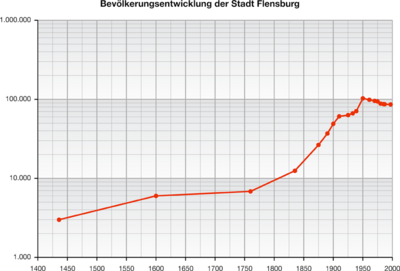 |
| Year | Population |
|---|---|
| 1436 | 3,000 |
| 1600 | 6,000 |
| 1760 | 6,842 |
| 1835 | 12,483 |
| 1 December 1875 ¹ | 26,474 |
| 1 December 1890 ¹ | 36,894 |
| 1 December 1900 ¹ | 48,937 |
| 1 December 1910 ¹ | 60,922 |
| 16 June 1925 ¹ | 63,139 |
| 16 June 1933 ¹ | 66,580 |
| 17 May 1939 ¹ | 70,871 |
| 13 September 1950 ¹ | 102,832 |
| 6 June 1961 ¹ | 98,464 |
| 27 May 1970 ¹ | 95,400 |
| 30 June 1975 | 93,900 |
| 30 June 1980 | 88,200 |
| 30 June 1985 | 86,900 |
| 27 May 1987 ¹ | 86,554 |
| 30 June 1997 | 86,100 |
| 31 December 2003 | 85,300 |
| 31 December 2012 | 89,375 |
¹ Census results
The Danish Community in Flensburg
The Danish community in Flensburg runs its own schools, libraries, and churches. People from the German majority are also welcome there. These two groups live together in a good way. Sometimes, a mix of Danish and German, called Petuh, is spoken on ferries.
Denmark also has a Consulate-General in Flensburg.
In Denmark, Flensburg is often known for its "border shops". These shops sell things like drinks and candy at lower prices than in Denmark. This is because taxes are lower in Germany.
| Largest minority groups | |
| Nationality | Population (December 31, 2022) |
| 3,095 | |
| 2,930 | |
| 2,455 | |
| 1,285 | |
| 1,120 | |
Flensburg's Coat of Arms
Flensburg's coat of arms has a red tower on a gold background. Blue and silver waves are below it. From the tower, you can see the two lions of Schleswig and Denmark. Above them is a red shield with a silver nettle leaf, which stands for Holstein. The town's flag is blue with the colorful coat of arms on it.
The lions represent Schleswig. The nettle leaf represents Holstein. This shows that the town is connected to these two historic regions. The tower reminds us of Flensburg's old town rights and the old castle that gave the town its name. The waves show that the town is on the Flensburg Fjord.
King Wilhelm II of Prussia gave the town this coat of arms in 1901. It was approved again in a slightly changed form in 1937.
Flensburg's Sister Cities
Flensburg has special connections with other cities around the world. These are called sister cities:
 Carlisle, United Kingdom
Carlisle, United Kingdom Neubrandenburg, Germany
Neubrandenburg, Germany Słupsk, Poland
Słupsk, Poland
Economy and Transport in Flensburg
Energy in Flensburg
Flensburg has a good system for heating homes and businesses. It uses Combined Heat and Power and District Heating. This system was built between 1970 and 1980 and is owned by the town.
Getting around Flensburg
The A 7 Autobahn runs west of Flensburg. It goes north to the Danish border and continues as European route E45. Other main roads, B 200 and B 199, also pass through the town.
The Flensburg-Schäferhaus airport is located west of the town.
Local buses provide public transport. Companies like Aktiv Bus GmbH and Allgemeinen Flensburger Autobus Gesellschaft (AFAG) run these buses. They all use the same ticket system within Flensburg. You can even use one ticket to travel from anywhere in Schleswig-Holstein or Hamburg to Flensburg by bus.
The Flensburg station opened in 1927. From here, trains go to Neumünster, Hamburg, and Fredericia. Some are fast InterCity trains. There are also regional trains to Eckernförde and Kiel. An older tram system was replaced by buses in 1973.
Media in Flensburg
In Flensburg, you can read the Flensburger Tageblatt newspaper every day. There is also the Flensborg Avis, which is printed in both German and Danish. Two free weekly advertising papers are MoinMoin and Wochenschau. You can also find the Flensburg Journal and a town magazine called Partout.
Norddeutscher Rundfunk (NDR) has one of its oldest studios in Flensburg. The town also has several radio transmitters. On the Fuchsberg hill, NDR broadcasts radio and television. This transmitter is famous because Germany's surrender was announced through it on May 8, 1945.
The "Offener Kanal" ("Open Channel") shows programs made by local citizens. You can watch these on cable television, mostly in the evenings.
Public organizations
Flensburg is home to several important organizations:
- Handwerkskammer Flensburg (Chamber of Skilled Crafts)
- IHK Flensburg (Chamber of Trade and Industry)
- Kraftfahrt-Bundesamt (federal office for road traffic)
Learning and Education
- University of Flensburg has about 6,000 students. It started as a teaching college in 1946 and became a university in 1994. It offers many programs and can award doctorates.
- Flensburg University of Applied Sciences is a technical college with over 3,000 students. It began as a school for steamship engineers in 1886. It became a university of applied sciences in 1973.
- Marineschule Mürwik (Naval Academy at Mürwik) is the main training center for all German Navy officers.
- Flensburger Volkshochschule (German Folk high school) offers adult education.
- Voksenundervisningen is a Danish adult education center.
Flensburg also has many other training and professional schools, including Danish ones. The town is home to Schleswig-Holstein's Central State Library and a university library. The Danish Central Library for South Schleswig offers Danish language courses and has a large collection of materials about the border area's history. Flensburg also has an extensive town archive.
Culture and Places to See
Flensburg has a well-preserved Old Town with many historic sights. The buildings along the waterfront are very special. Even though some old buildings were replaced, Flensburg still has a compact and well-preserved Old Town.
Theaters in Flensburg
- Schleswig-Holsteinisches Landestheater (at the Stadttheater) and Symphony Orchestra
- Niederdeutsche Bühne der Stadt Flensburg (Low German Stage)
- Det Lille Teater (Danish theater)
- Theaterwerkstatt Pilkentafel (Theater Workshop)
- Orpheus-Theater
Archives and Libraries
- Town Archive: A very large collection at the town hall.
- Dansk Centralbibliotek for Sydslesvig: Has an archive of the Danish minority.
- Town Library
- State Central Library and Zentrale Hochschulbibliothek (Central College Library)
Museums to visit
- Museumsberg: A museum about art and cultural history.
- Schifffahrtsmuseum: A museum about shipping and shipbuilding.
- Rummuseum: Tells the story of Flensburg as a "Rum Town".
- Naturwissenschaftliches Museum: Shows animals and plants from northern Schleswig-Holstein.
- Museumshafen: A private group that keeps old traditional working boats.
- Museumswerft: Shows how ships were built in past centuries. It also has a children's boatyard.
- Fischereimuseum: Located at the old fishing harbor.
- Phänomenta: A place to experience and understand science and technology.
- Salondampfer "Alexandra": A passenger steamer built in 1908. It takes regular trips in the Flensburg Fjord.
- Klassische Yachten Flensburg: A private harbor for classic yachts.
- Gerichtshistorische Sammlung: A collection about legal history at the Flensburg State Court.
- Bergmühle: An association that keeps up a historic windmill from 1792.
- Johannesburger Heimatstube: Has documents and pictures from East Prussia.
Important buildings
Flensburg has many old and beautiful buildings.
- Johanniskirche (Saint John's Church): The oldest church in the town, from the 12th century.
- Marienkirche (Saint Mary's Church): A High Gothic church with Baroque additions.
- Nikolaikirche (Saint Nicholas' Church): A Gothic main church with a famous organ.
- Heiliggeistkirche (Church of the Holy Spirit): A former chapel.
- Franziskanerkloster (Franciscan Monastery): Ruins from 1263.
- Nordertor: An old town gate and a symbol of Flensburg.
- Kompagnietor: Another gate, built in 1602, used by shipping companies.
- Alt-Flensburger Haus: The home of the Eckener brothers' parents.
- Flensborghus: A former orphanage, now the seat of the Danish minority.
- Many old merchants' houses along Holm-Große Straße-Norderstraße.
- Südermarkt 9: Has the town's oldest house.
- Nordermarkt: A market square with the Schrangen (market hall) and Neptunbrunnen (fountain).
- Rote Straße: Has nice craftsmen's houses.
- Jürgenstraße: Features the Gängeviertel, a neighborhood with very narrow streets and dense buildings.
- Oluf-Samson-Gang: A charming lane with small half-timbered houses.
- Row of warehouses
- Ship bridge (Schiffbrücke): A long quay on the harbor.
- Small ruins of the town wall near the Nikolaikirche.
- Bergmühle and Johannismühle: Old windmills.
- Deutsches Haus: A large hall for gatherings and events.
- Flensburg station (Main Railway Station): Completed in 1929.
- Town Hall: A seventeen-floor building from 1964, renovated in 1997.
- Altes Gymnasium: Built in 1914, Flensburg's oldest high school, founded in 1566.
- Duborg Skolen: Flensburg's Danish high school.
Parks and green spaces
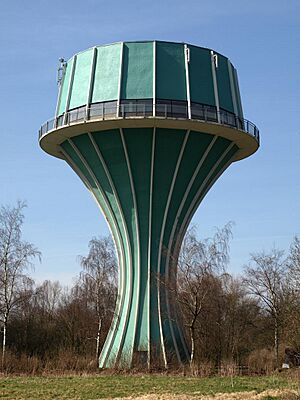
- Old Cemetery: A park with interesting grave markers from the 1800s.
- Christiansenspark: Part of a large landscape park.
- Volkspark: A park in the eastern part of town.
- Marienhölzung: Woods in the western part of town.
Fun events in Flensburg
- May/June: Rumregatta (yearly boat race).
- May/June: Danske Årsmøder (yearly Danish meetings).
- June/December: Campusfete (twice a year, a party for students).
- June: Rote-Straße-Fest (yearly street festival).
- July: Dampf-Rundum (every two years, a steam festival).
- July/August: Flensburger Hofkultur (yearly summer cultural program).
- August: Flensburger Tummelum (Old Town Festival, every two years).
- October: Apfelfahrt des Museumshafen (yearly apple boat trip).
- October: "Flensburg Shortfilmfestival" (yearly).
- December: Christmas market (yearly).
Famous People from Flensburg
Honorary citizens
Flensburg has given honorary citizenship to these people:
- 1851: Friedrich Ferdinand Tillisch, a minister.
- 1857: Christian Rønnenkamp, a salesman and shipowner.
- 1867: Edwin Freiherr von Manteuffel, a Prussian Governor.
- 1872: Karl von Wrangel, a General.
- 1895: Otto Fürst von Bismarck, a German Chancellor.
- 1911: Friedrich Wilhelm Selck, a Commercial Councillor.
- 1917: Heinrich Schuldt, a Town Councillor.
- 1924: Hugo Eckener, a pioneer in aviation.
- 1930: Hermann Bendix Todsen, a mayor.
- 1999: Beate Uhse-Rotermund, an aviator and businesswoman.
Special Resident
- Isted Lion: This war monument was first in Flensburg. It then moved to Berlin and Copenhagen. Now, it is back in Flensburg.
Born in Flensburg
Many talented people were born in Flensburg:
Artists and performers
- Melchior Lorck (1526/27–1583): A painter and printmaker from the Renaissance.
- Heinrich Jansen (1625–1667): A Danish Baroque painter.
- Caius Gabriel Cibber (1630–1700): A Danish sculptor.
- Hermann Vogel (1856–1918): A French painter and illustrator.
- Adolf Strodtmann (1829–1879): A German poet and journalist.
- Ludwig Dettmann (1865–1944): A German impressionist painter.
- Hans Christiansen (1866–1945): An artistic craftsman.
- Elvira Madigan (1867–1889): A Danish tightrope walker.
- Ella Heide (1871–1956): A Danish painter.
- Wilhelm von Brincken (1881–1946): An American actor and German spy.
- Emmy Hennings (1885–1948): A writer and poet.
- Dieter Thomas Heck (born 1937): A German television presenter and actor.
- Pippa Steel (1948–1992): A British actress.
- Peter Lund (born 1965): A theater director and author.
Musicians
- Carla Spletter (1911–1953): A German opera singer.
- Frank Dostal (born 1945): A German songwriter and singer.
- Christian Broecking (born 1957): A music expert and critic.
- Andreas Delfs (born 1959): A music director.
- Dorothea Röschmann (born 1967): An opera singer.
- DJ Koze (born 1972): A German DJ and music producer.
- Kim Frank (born 1982): A singer and actor.
- Ingrid Verena Timm (born 1985): A musician and teacher.
Scientists and religious figures
- Lütke Namens (1497–1574): The last Franciscan friar in Flensburg.
- Thomas Fincke (1561–1656): A Danish mathematician and physicist.
- Heinrich Harries (1762–1802): A German Protestant pastor.
- Hans Lassen Martensen (1808–1884): A Danish bishop and academic.
- Theodor von Jürgensen (1840–1907): An internist (doctor).
- Hugo Eckener (1868–1954): A pioneer of German airship travel.
- Carl Wilhelm Otto Werner (1879–1936): A German doctor.
- Hans Asmussen (1898–1968): A German theologian.
- Lorenz Magaard (born 1934): A German-American mathematician.
- Tim Clausen (born 1969): A structural biologist.
Sports figures
- Charles Meyer (1868–1931): A Danish racing cyclist.
- Haide Klüglein (born 1939): A swimmer.
- Kristian Poulsen (born 1975): A Danish racing driver.
- Sascha Görres (born 1980): A footballer.
- Kolja Afriyie (born 1982): A football defender.
- Niels Hansen (born 1983): A football midfielder.
- Pierre Becken (born 1987): A footballer.
Flensburg's Weather
| Climate data for Leck (1991–2020 normals) | |||||||||||||
|---|---|---|---|---|---|---|---|---|---|---|---|---|---|
| Month | Jan | Feb | Mar | Apr | May | Jun | Jul | Aug | Sep | Oct | Nov | Dec | Year |
| Mean daily maximum °C (°F) | 4.1 (39.4) |
4.5 (40.1) |
7.3 (45.1) |
12.5 (54.5) |
16.3 (61.3) |
19.0 (66.2) |
21.5 (70.7) |
21.4 (70.5) |
17.8 (64.0) |
13.0 (55.4) |
8.0 (46.4) |
5.0 (41.0) |
12.5 (54.5) |
| Daily mean °C (°F) | 1.9 (35.4) |
1.9 (35.4) |
3.9 (39.0) |
7.7 (45.9) |
11.6 (52.9) |
14.7 (58.5) |
17.0 (62.6) |
16.8 (62.2) |
13.7 (56.7) |
9.7 (49.5) |
5.6 (42.1) |
2.9 (37.2) |
8.9 (48.0) |
| Mean daily minimum °C (°F) | −0.5 (31.1) |
−0.6 (30.9) |
0.5 (32.9) |
3.1 (37.6) |
6.5 (43.7) |
9.8 (49.6) |
12.0 (53.6) |
11.9 (53.4) |
9.5 (49.1) |
6.3 (43.3) |
2.8 (37.0) |
0.3 (32.5) |
5.1 (41.2) |
| Average precipitation mm (inches) | 70.0 (2.76) |
50.6 (1.99) |
48.7 (1.92) |
35.1 (1.38) |
48.9 (1.93) |
72.5 (2.85) |
80.1 (3.15) |
92.2 (3.63) |
89.4 (3.52) |
91.5 (3.60) |
77.5 (3.05) |
81.8 (3.22) |
852.7 (33.57) |
| Average precipitation days (≥ 1.0 mm) | 20.0 | 17.0 | 16.2 | 12.8 | 13.1 | 14.9 | 15.4 | 17.8 | 17.1 | 18.9 | 19.4 | 20.6 | 200.7 |
| Average relative humidity (%) | 90.9 | 88.5 | 84.7 | 77.7 | 76.0 | 77.3 | 78.1 | 80.0 | 83.7 | 86.8 | 90.3 | 91.6 | 83.8 |
| Mean monthly sunshine hours | 45.1 | 63.3 | 120.7 | 187.8 | 232.8 | 219.1 | 222.0 | 199.6 | 143.9 | 94.8 | 51.0 | 37.8 | 1,611.3 |
| Source: World Meteorological Organization | |||||||||||||
Images for kids
See also
 In Spanish: Flensburgo para niños
In Spanish: Flensburgo para niños




